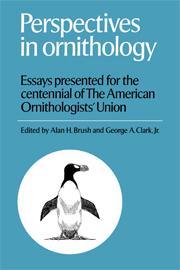 Perspectives in Ornithology
Perspectives in Ornithology Book contents
- Frontmatter
- Contents
- List of contributors
- Preface
- Introduction
- 1 Captive birds and conservation
- 2 Research collections in ornithology – a reaffirmation
- 3 On the study of avian mating systems
- 4 Cooperative breeding strategies among birds
- 5 Ecological energetics: what are the questions?
- 6 Perspectives in optimal foraging
- 7 Biochemical studies of microevolutionary processes
- 8 Organization of the avian genome
- 9 The origin and early radiation of birds
- 10 Avian community ecology: an iconoclastic view
- 11 Biogeography: the unification and maturation of a science
- 12 Bird song learning: theme and variations
- 13 Bird navigation
- Index
9 - The origin and early radiation of birds
Published online by Cambridge University Press: 04 August 2010
- Frontmatter
- Contents
- List of contributors
- Preface
- Introduction
- 1 Captive birds and conservation
- 2 Research collections in ornithology – a reaffirmation
- 3 On the study of avian mating systems
- 4 Cooperative breeding strategies among birds
- 5 Ecological energetics: what are the questions?
- 6 Perspectives in optimal foraging
- 7 Biochemical studies of microevolutionary processes
- 8 Organization of the avian genome
- 9 The origin and early radiation of birds
- 10 Avian community ecology: an iconoclastic view
- 11 Biogeography: the unification and maturation of a science
- 12 Bird song learning: theme and variations
- 13 Bird navigation
- Index
Summary
Historical perspective
According to Fisher (1967), the first described avian paleospecies was Larus toliapicus (Konig 1825). Thus, the story of fossil birds barely exceeds 150 years, and the 100 years of the American Ornithologists' Union include nearly two-thirds of this. During most of this time, a major burden for paleornithologists has been a lack of comparative skeletons of recent birds. We are now beginning to solve this problem, and modern collections exist with thousands of skeletons covering about two-thirds of the world's species.
The other major problem is the incompleteness of most avian fossils. Fragmentary materials rarely contribute to improving avian systematics and thus limit the impact of paleornithology. The few studies that have used excellent specimens (Marsh 1880; Wellnhofer 1974; Harrison and Walker 1976a; Martin and Tate 1976; Olson 1977), illustrate how much more convincing conclusions are when based on more than one skeletal element. Such studies are possible for less than 10% of the total fossil record of birds, and studies of distribution, both geographic and temporal, must rely on less complete specimens.
Fisher (1967) summarized the distribution of fossil birds and estimated the early avian diversification. Shufeldt and Lambrecht were among the first to estimate the diversity of past avifaunas. Shufeldt realized knowing the osteology of Recent birds was fundamental to understanding fossil ones, and he made numerous osteological contributions (Shufeldt 1909).
- Type
- Chapter
- Information
- Perspectives in OrnithologyEssays Presented for the Centennial of the American Ornitholgists' Union, pp. 291 - 354Publisher: Cambridge University PressPrint publication year: 1983
- 70
- Cited by


